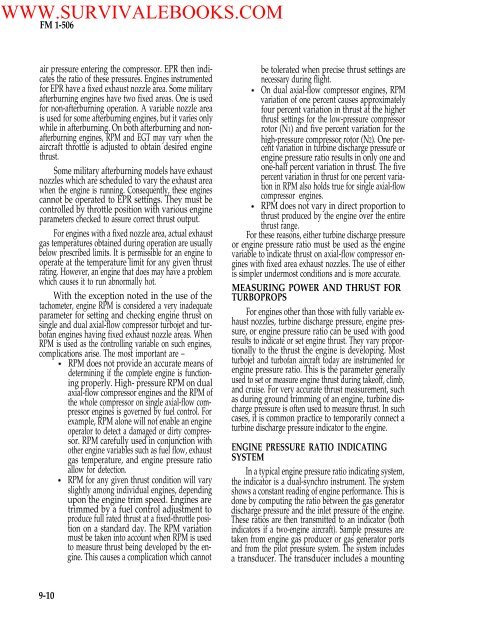FM 1-506 Fundamentals of Aircraft Power Plants ... - Survival Books
FM 1-506 Fundamentals of Aircraft Power Plants ... - Survival Books
FM 1-506 Fundamentals of Aircraft Power Plants ... - Survival Books
Create successful ePaper yourself
Turn your PDF publications into a flip-book with our unique Google optimized e-Paper software.
WWW.SURVIVALEBOOKS.COM<strong>FM</strong> 1-<strong>506</strong>air pressure entering the compressor. EPR then indicatesthe ratio <strong>of</strong> these pressures. Engines instrumentedfor EPR have a fixed exhaust nozzle area. Some militaryafterburning engines have two fixed areas. One is usedfor non-afterburning operation. A variable nozzle areais used for some afterburning engines, but it varies onlywhile in afterburning. On both afterburning and nonafterburningengines, RPM and EGT may vary when theaircraft throttle is adjusted to obtain desired enginethrust.Some military afterburning models have exhaustnozzles which are scheduled to vary the exhaust areawhen the engine is running. Consequently, these enginescannot be operated to EPR settings. They must becontrolled by throttle position with various engineparameters checked to assure correct thrust output.For engines with a fixed nozzle area, actual exhaustgas temperatures obtained during operation are usuallybelow prescribed limits. It is permissible for an engine tooperate at the temperature limit for any given thrustrating. However, an engine that does may have a problemwhich causes it to run abnormally hot.With the exception noted in the use <strong>of</strong> thetachometer, engine RPM is considered a very inadequateparameter for setting and checking engine thrust onsingle and dual axial-flow compressor turbojet and turb<strong>of</strong>anengines having fixed exhaust nozzle areas. WhenRPM is used as the controlling variable on such engines,complications arise. The most important are –RPM does not provide an accurate means <strong>of</strong>determining if the complete engine is functioningproperly. High- pressure RPM on dualaxial-flow compressor engines and the RPM <strong>of</strong>the whole compressor on single axial-flow compressorengines is governed by fuel control. Forexample, RPM alone will not enable an engineoperator to detect a damaged or dirty compressor.RPM carefully used in conjunction withother engine variables such as fuel flow, exhaustgas temperature, and engine pressure ratioallow for detection.RPM for any given thrust condition will varyslightly among individual engines, dependingupon the engine trim speed. Engines aretrimmed by a fuel control adjustment toproduce full rated thrust at a fixed-throttle positionon a standard day. The RPM variationmust be taken into account when RPM is usedto measure thrust being developed by the engine.This causes a complication which cannotbe tolerated when precise thrust settings arenecessary during flight.On dual axial-flow compressor engines, RPMvariation <strong>of</strong> one percent causes approximatelyfour percent variation in thrust at the higherthrust settings for the low-pressure compressorrotor (N1) and five percent variation for thehigh-pressure compressor rotor (N2). One percentvariation in turbine discharge pressure orengine pressure ratio results in only one andone-half percent variation in thrust. The fivepercent variation in thrust for one percent variationin RPM also holds true for single axial-flowcompressor engines.RPM does not vary in direct proportion tothrust produced by the engine over the entirethrust range.For these reasons, either turbine discharge pressureor engine pressure ratio must be used as the enginevariable to indicate thrust on axial-flow compressor engineswith fixed area exhaust nozzles. The use <strong>of</strong> eitheris simpler undermost conditions and is more accurate.MEASURING POWER AND THRUST FORTURBOPROPSFor engines other than those with fully variable exhaustnozzles, turbine discharge pressure, engine pressure,or engine pressure ratio can be used with goodresults to indicate or set engine thrust. They vary proportionallyto the thrust the engine is developing. Mostturbojet and turb<strong>of</strong>an aircraft today are instrumented forengine pressure ratio. This is the parameter generallyused to set or measure engine thrust during take<strong>of</strong>f, climb,and cruise. For very accurate thrust measurement, suchas during ground trimming <strong>of</strong> an engine, turbine dischargepressure is <strong>of</strong>ten used to measure thrust. In suchcases, it is common practice to temporarily connect aturbine discharge pressure indicator to the engine.ENGINE PRESSURE RATIO INDICATINGSYSTEMIn a typical engine pressure ratio indicating system,the indicator is a dual-synchro instrument. The systemshows a constant reading <strong>of</strong> engine performance. This isdone by computing the ratio between the gas generatordischarge pressure and the inlet pressure <strong>of</strong> the engine.These ratios are then transmitted to an indicator (bothindicators if a two-engine aircraft). Sample pressures aretaken from engine gas producer or gas generator portsand from the pilot pressure system. The system includesa transducer. The transducer includes a mounting9-10
















